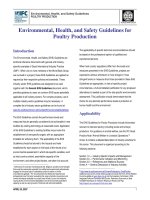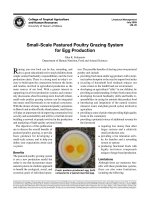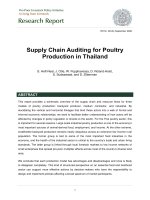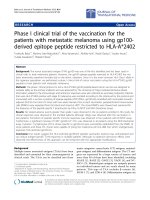Temperature Optimization for Bioethanol Production from Corn Cobs Using Mixed Yeast Strains pot
Bạn đang xem bản rút gọn của tài liệu. Xem và tải ngay bản đầy đủ của tài liệu tại đây (118.82 KB, 6 trang )
OnLine Journal of Biological Sciences 10 (2): 103-108, 2010
ISSN 1608-4217
© 2010 Science Publications
Corresponding Author: Clarence S. Yah, School of Chemical and Metallurgical Engineering,
Faculty of Engineering and the Built Environment, University of the Witwatersrand,
Wits 2050 Johannesburg, South Africa
Tel.: 011 7177594 Fax: 011 7177599
103
Temperature Optimization for Bioethanol Production from Corn Cobs
Using Mixed Yeast Strains
Clarence S. Yah, Sunny E. Iyuke, Emmanuel I. Unuabonah, Odelia Pillay,
Chetty Vishanta and Samuel M. Tessa
School of Chemical and Metallurgical Engineering,
Faculty of Engineering and the Built Environment, University of the Witwatersrand,
Wits 2050 Johannesburg, South Africa
Abstract: Problem statement: Dilute sulphuric acid and enzymatic hydrolysis methods were used for
sugar extraction. Xylose and glucose sugars were obtained from corn cobs. Approach: Acid
hydrolysis of corn cobs gave higher amount of sugars than enzymatic hydrolysis. Results: The results
showed that optimal temperature and time for sugar fermentation were approximately 25°C and 50 h
by two yeast strains (S. cerevisiae and P. Stipitis) respectively. At 20 and 40°C, less bioethanol was
produced. Bioethanol produced at 25°C was 11.99 mg mL
−1
, while at 40 and 20°C were 2.50 and
6.40 mg mL
−1
respectively. Conclusion/Recommendations: Data obtained revealed that xylose level
decreased from 27.87-3.92 mg mL
−1
during the first 50 h of fermentation and complete metabolism of
glucose was observed during this time. Xylose and bioethanol levels remained constant after 50 h.
Varying the temperature of the fermentation process improves the effective utilization of corn cobs
sugars for bioethanol production can be achieved.
Key words: Bioethanol, corn cobs, optimization, fermentation, hydrolysis
INTRODUCTION
In an attempt to maximize waste product into
useful material, this article seeks to determine the
optimal temperature for large scale bioethanol
production from corn cobs. Corn cob, a waste product
of corn contains large amount of sugars that can be
further utilized to produce various compounds
(Cao et al., 1996; Adesanya and Raheem, 2009). The
bioconversion of lignocellulosics to biofuel from cheap
non-edible materials such as corn cob for renewal
energy is imperative. Thus, by varying temperature
conditions during the fermentation process, maximum
productivity of biofuel on an industrial scale can be
optimized.
In the brewing industry, production of biofuel is
carried out by the fermentation of starchy materials, in
which case, sugars are converted into bioethanol with
carbon dioxide and water (Hongguang, 2006) as by-
products. For waste plant materials to be valuable, it
must be converted to fuel as a sustainable substitute to
fossil fuel. Therefore, there is a need for renewable
energy resources from non-edible agricultural sources
such as corn cob to replace fossil forms. This is because
gas emissions from plant feedstock fuel are less than
those emitted by fossil forms and thus beneficial to the
environment and global warming (Demirbas, 2005;
Hongguang, 2006). Bioethanol produced from corn
uses only a small part of the plant material, whereby only
the starch from the kernel is transformed into bioethanol
(Cao et al., 1996). Several research studies have been
carried out on the production of bioethanol from corn
cobs through simultaneous saccharification and
fermentation of lignocellulosic agricultural wastes by
Kluyveromyces marxianus 6556 (Zhang et al., 2009),
using Aspergillus niger and Saccharomyces cerevisae in
simultaneous saccharification and fermentation
(Zakpaa et al., 2009) and from Lignocellulosic
Biomass (Kumar et al., 2009).
Corn however, is a main staple food in South
Africa with an annual production of 8.04 million tons
(Adesanya and Raheem, 2009). The cobs produced
from corn are mainly used as manure for agricultural
production. According to the report of Latif and Rajoka
(2001), modern biotechnology allows the use of such
lignocellulosic substrates as corn cobs in the production
of chemicals and fuels, utilizing microorganisms. It has
been shown that when corn is used for bioethanol
OnLine J. Biol. Sci., 10 (2): 103-108, 2010
104
production at higher temperatures, yeast cells die
resulting in a decrease in alcohol yield when the pulp is
concentrated, while optimal temperature for maximum
productivity occurs at 32°C (Araque et al., 2008). It is
therefore, necessary to select the optimum temperature
at which yeast strains can ferment the sugars from
lignocellulosic material.
The Simultaneous Saccharification and
Fermentation (SSF) process has been identified as
economically viable for the conversion of these
substrates to fermentation products (Cao et al., 1996).
Conversion of glucose and xylose to ethanol by co-
yeast strains has been successfully obtained by
Taniguchi et al. (1997) using a respiratory deficient
mutant of Saccharomyces cerevisiae and Pitchia
stipitis. Pichia stipitis strains ferment xylose at a high
capacity of 57 g L
−1
than any other yeast, provided the
pH is maintained at between 4.5 and 6 and temperature
of 25-26°C (Jeffries et al., 2007). According to
Jeffries et al. (2007), maximum yield of ethanol is
obtained when a mixture of S. cerevisiae and P. stipitis
are introduced into a medium containing both glucose
and xylose. The amount of bioethanol produced
therefore, depends on the optimal temperature which,
invariably influence sugar utilization by yeast cells
(Mwesigye and Barford, 1996).
Problem statement: From the above it is obvious
several microorganisms have used in the production of
bioethanol but non has utilized a combination of
S. cerevisiae and P. stipitis in the production of
bioethanol from corn cobs. This study, therefore,
utilized an agricultural waste material (corn cobs) in the
production of bioethanol as a cheap but effective
alternative fuel source to power automobile.
Furthermore, time and temperature in the bioethanol
production process using the two yeast strains
(S. cerevisiae and P. stipitis) were optimized.
MATERIALS AND METHODS
The chemicals and reagents used in the study were
of analytical grade. The sugar extraction process from
the corn cobs was according to Cao et al. (1996). The
sugar analyses were determined using the HPLC
(Agilent Technologies, Waldbronn, Germany). Two
strains of yeast: S. cerevisiae and P. stipitis were used
for the fermentation experiment and were obtained
from the School of Molecular Biology, University of
the Witwatersrand.
Approach: Methods used in the production of
bioethanol in this study were the acid hydrolysis and
the enzyme hydrolysis methods after the corn cob were
steeped in ammonia hydroxide solution to release lignin
from the cob. Both methods were compared to
determine which gives better yield of fermentable
sugars. The fermentable sugars were then treated with
the yeast strains at different temperatures and time. This
is to optimize the temperature and time in the use of
both yeast strains in the production of bioethanol from
corn cob.
Ammonia steeping: Twenty grams of milled corn cobs
of particle size of 2 mm was mixed with 100 mL 2.9 M
NH
4
OH solution in a 250 mL Erlenmeyer flask. The
mixture was then incubated in a shaker for 24 h at
30°C. The content was then filtered using a 2 µm filter
paper into 250 mL Erlenmeyer flask. It was further
rinsed twice using distilled water. The corn cobs were
then dried at 30°C in an oven overnight.
Dilute acid hydrolysis: The dried corn cobs were then
delignified by treating with 0.3 M HCl solution at
121°C for 1 h. The amount of HCl added to dry
biomass weight is in the ratio of 1:10 w/v. 0.5 M NaOH
was then used to neutralize the acidic hemicellulose
hydrolyzate. The pre-treated cellulosic residue was then
washed with distilled water to remove residual acid.
Enzymatic hydrolysis: In a 250 mL flask, 50 mL of
water and 300 µL of cellulase was added to the
cellulosic residue to convert cellulose to fermentable
sugars at 50°C for 48 h (Sun and Cheng, 2002).
Yeast culture: Each yeast strain was grown in cooled
25 mL broth Yeast Potato Dextrose (YPD) medium
prepared by adding 1 g of yeast extract, 2 g of peptone
powder and 2 g of glucose powder to 25 mL of distilled
water and autoclaved at121°C for 15 min. The cultured
medium was then placed in an incubator shaker at
220 rpm for 18 h.
Bioethanol fermentation: Twenty five ml each of
hemicellulose hydrolyzate and cellulose hydrolyzate
were mixed, inoculated in 500 µL each of yeast
medium and covered with cheese cloth to allow for
proper gaseous exchange. The samples were then put
into incubator shakers at different temperatures and
shaken for 180 rpm. The sugar concentrations were
then analysed with HPLC according to the method
described by Duke and Henson (2008). In order to
remove the yeast cells from the fermentation products,
the cultured broth were sterilely filtered. The
temperature was varied from 15-40°C. The
fermentation process was carried out according to
Cao et al. (1996).
OnLine J. Biol. Sci., 10 (2): 103-108, 2010
105
RESULTS
In order to investigate the optimum temperature the
acid and enzymatic hydrolysis were used to determine
the amount of sugars produced. There was a significant
difference (p<0.001) of the sugars obtained from acid
and enzymatic hydrolysis. The results showed that the
acid hydrolysis produced 1.6 and 30.23 mg mL
−1
of
glucose and xylose sugars respectively while the
enzymatic hydrolysis gave 0.12 and 5.7 mg mL
−1
of
glucose and xylose sugars respectively. This indicates
that enzymatic hydrolysis produces fewer sugars than
acid hydrolysis (Fig. 1). The fermentation process was
repeated for the temperatures 20, 25, 30 and 40°C.
During the fermentation process, the levels of glucose,
xylose and bioethanol were measured after every 5 h.
The result in Fig. 2 shows the concentration of
glucose during the fermentation period. It was found
that the level of sugar utilization by the yeast strains
was faster at 25°C than at 20, 30 and 40°C. It took 25 h
for the glucose to be completely metabolized at 25°C,
50 h at 20 and 30°C respectively. It also took 63 h for
the glucose to be metabolized by the yeast strains at
40°C (Fig. 2). The glucose concentrations for the
temperatures 20, 25, 30 and 40°C all dropped from
0.74-0 mg mL
−1
at time 25 h (25°C), 50 h (20 and
30°C) and 63 h (40°C) (Fig. 2).
The results of xylose fermentation at varying
temperatures are shown in Fig. 3. The results indicated
that at 25°C, the yeast strains utilize the xylose faster
than at any other temperature. The utilization was poor
at 20, 30 and 40°C (Fig. 3). The xylose concentrations
for the temperatures 20, 25, 30 and 40°C all dropped
from 29.77-11.99 mg mL
−1
(20°C), 3.92 mg mL
−1
(25°C), 5.80 mg mL
−1
(30°C) and 15.01 mg mL
−1
(40°C) respectively at time 50 h (Fig. 3).
Fig. 1: The concentration of sugars produced from corn
cobs using both acid and enzymatic hydrolysis
The result of the bioethanol concentration at the
various temperatures is shown in Fig. 4. The two yeast
cells were able to ferment the sugars at optimum
temperature (Fig. 4).
The highest concentration of bioethanol produced
from both sugars was 11.99 mg mL
−1
at 25°C. The
lowest concentration of bioethanol produced was
2.47 mg mL
−1
at a temperature of 40°C. At
temperatures of 20 and 30°C, the concentrations of
bioethanol were found to be 6.40 and 11.08 mg mL
−1
respectively (Fig. 4).
Figure 5 shows the production of bioethanol at 25°C.
The results showed that the concentrations of the sugars
decreased while the concentration of bioethanol increased
with respect to time. According to Jeffries et al. (2007) by
using S. cerevisiae only, the glucose gets converted
quickly (after about 12.5 h), while the xylose takes
approximately 48 h to be converted to bioethanol and
other products. Therefore, the addition of P. stipitis yeast
to S. cerevisiae enhanced the conversion rate of the
sugars into bioethanol.
Fig. 2: The amount of Glucose fermentation from corn
cob by S. cerevisiae and P. Stipitis
Fig. 3: The amount of Xylose fermentation from corn
cob by S. cerevisiae and P. Stipitis
OnLine J. Biol. Sci., 10 (2): 103-108, 2010
106
Fig. 4: The amount of bioethanol produced from
glucose and xylose sugars
Fig. 5: Temperature optimization of bioethanol
production from glucose and xylose sugars at
25°C
Figure 5 shows that the concentrations of glucose and
xylose decrease as the concentration of bioethanol
increased to a constant concentration of 11.99 mg mL
−1
at
25°C. All of the glucose was used up. However, the final
concentration of xylose was found to be 3.92 mg mL
−1
after 50 h.
DISCUSSION
The high concentration of xylose present after acid
hydrolysis (Fig. 1), could be due to the fact that very small
amount of lignin was removed during ammonia steeping.
Similar observation has been made by Cao et al. (1996)
and Kumar et al. (2009) where they found very high
amounts of xylose produced during acid hydrolysis
from hemicellulosic material. The analytical studies
reveal glucose level of 1.62 mg mL
−1
during acid
hydrolysis and enzymatic level of 0.12 mg mL
−1
. The
concentration of the sugar hydrolysates after acid
hydrolysis was similar to previous reports by Latif and
Rajoka (2001). The xylose fraction during acid
hydrolysis was 30.23 mg mL
−1
as compared to
5.70 mg mL
−1
of enzymatic hydrolysis. This also
follows similar findings by Deng et al. (2007) that
cellulosic biomass can be easily be hydrolyzed with
dilute acid to produce monomeric sugars. The high
xylose production was due to the ammonia steeping
process which stimulated the cellulosic materials to
swell, therefore promoting the efficiency of the acid
hydrolysis process. This finding confirm earlier reports
by Cao et al. (1996) that after the ammonia steeping
process the corn cob hemicellulosic fraction can easily
be hydrolyzed by dilute acid as well as separated from
the cellulosic fraction. Thus, acid hydrolysis of corn
cobs after ammonia steeping gave better yield of
fermentable sugar than the enzymatic method.
According to Fig. 2 and 3, the concentrations of
xylose and glucose decreased with respect to and
temperatures time for all temperatures (Cao et al.,
1996). It can also be seen that between 25 and 30°C, the
sugars were used up faster than at 20 and 40°C. It can
be seen that at 25°C, the glucose concentration reached
0 mg mL
−1
after 25 h and the concentration at 30°C
reached 0 mg mL
−1
after 50 h. The reason for this is
because S. cerevisiae and P. stipitis are known to
convert sugars into bioethanol at temperature range of
25 and 30°C (Van Vleet and Jeffries, 2009).
Figure 3 shows the concentration of xylose which
also decreased with respect to time for all temperatures
correlating with the reported by Cao et al. (1996). The
xylose was converted faster at 25°C than at 30°C. At
this temperature the xylose concentration was found to
be approximately 3.92 mg mL
−1
after 50 h. This could
be due to the fact that P. stipitis converts xylose into
bioethanol at an optimum temperature of 25°C
(Jeffries et al., 2007). Theoretically, 100 g of glucose
should produce approximately 50.4 g of bioethanol and
48.8 g of carbon dioxide. However, practically,
microorganisms use up most of the glucose sugar for
growth. Thus, the actual yield of bioethanol is less than
100 % (Araque et al., 2008). From literature it has been
shown that the operating temperatures are less than
expected because yeast cells performance may have been
inhibited by other inherent components within in the
fermentation process (Galitsky et al., 2003; Sinha et al.,
2006; Deng et al., 2007).
In Fig. 4, the concentration of the bioethanol was
found to increase with respect to time for all
temperatures which supports results obtained in literature
(Cao et al 1996; Demirbas, 2005). The highest amount
OnLine J. Biol. Sci., 10 (2): 103-108, 2010
107
of bioethanol was produced at 25°C and was found to
be 11.99 mg mL
−1
at approximately 50 h of
metabolism. The second highest concentration of
bioethanol at 30°C was found to be approximately
11.08 mg mL
−1
after 50 h. At 40°C, there was a poor
conversion of sugars and therefore the bioethanol
produced after 50 h was approximately 2.47 mg mL
−1
.
This suggests that 25
o
C and 50 h are the optimum
temperature and time for the production of bioethanol
using a combination of S. cerevisiae and P. stipitis
yeast strains.
During fermentation at high temperatures,
Araque et al. (2008) observed that some adaptable
resistance factors from the yeast cells can be generated
that can give rise to the difference in ethanol yield.
Similar effects were reported previously by Abdel-
Fattah et al. (2000). Initial rapid decrease of sugar
observed in Fig. 4 was due to a rapid multiplication of
yeast cells and the rapid conversion of the sugars to
alcohol via the glucose metabolism (Gibson et al.,
2008). Generally there was a positive correlation
between the sugar reduction of the fermenting medium
and a concomitant increase in the ethanol production
(Fig. 5). Figure 5 shows the optimum temperature of
bioethanol production from glucose and xylose at 25°C
where the highest amount of ethanol was produced.
Generally, during fermentation, monomeric sugars are
metabolized faster than di-, tri- and polymeric sugars.
There was a significant difference (p<0.001) in ethanol
production when the fermentation process approached
50 h after that the concentrations of xylose and
bioethanol remain constant. This is due to the yeast
cells dying and hence after this point no fermentation
was really successful.
CONCLUSION
Varying the temperature of the fermentation of
corn cobs sugars has an impact on bioethanol
production. It was observed that the concentration of
sugars (glucose and xylose) after enzymatic hydrolysis
was less than that of the acid hydrolysis. The results
showed that the combination of ammonia steeping
followed by dilute acid hydrolysis gave high amount of
sugars. The glucose and xylose concentrations were
found to decrease with respect to time whilst that of the
bioethanol was found to increase with respect to time.
The optimum time and temperature for bioethanol
production S. cerevisiae and P. stipitis strains were
found to be at 50 h and 25°C respectively.
ACKNOWLEDGEMENT
The authors acknowledge the financial support
from the National Research Fund (NRF) and SA-chair
Program, APV Invensys, equipment donation from
Falcon Engineering (Pty) Ltd, South Africa, raw
material supply from SABMiller of Alrode, South
Africa and moral and technical support from John
Cluett of IBD Africa Section and Anton Erasmus of
SABMiller, South Africa.
REFERENCES
Abdel-Fattah, W., M. Fadil, I. Banet, 2000. Isolation of
thermotolerant ethanologenic yeast and use of
selected strains in industrial scale fermentation in
an Egyptian distillery. Biotechnol. Bioeng.,
68: 531-532. PMID: 10797239
Adesanya, D.A. and A.A. Raheem, 2009. Development
of corn cob ash blended cement. Const. Build.
Mater., 23: 347-352. DOI:
10.1016/j.conbuildmat.2007.11.013
Araque, E., C. Parra, M. Rodriguez, J. Freer and J. Baeza,
2008. Selection of thermotolerant yeast strains
Saccharomyces cerevisiae for bioethanol
production. Enzyme Microb. Technol., 43: 120-123.
DOI: 10.1016/j.enzmictec.2008.02.007
Cao, N.J., M.S. Krishnan, J.X. Du, C.S. Gong and
N.W.Y. Ho et al., 1996. Ethanol production from
corn cob pretreated by the ammonia steeping
process using genetically engineered yeast.
Biotechnol. Lett., l18: 1013-1018. DOI:
10.1007/BF00129723
Demirbas, A., 2005. Bioethanol from cellulosic
materials: A renewable motor fuel from biomass.
Energy Sour., 27: 327-337. DOI:
10.1080/00908310390266643
Deng, L., Y. Wang, Y. Zhang and M.A. Runyu, 2007.
The enhancement of ammonia pretreatment on the
fermentation of rice straw hydrolysate to xylitol. J.
Food Biochem., 31: 195-205. DOI:
10.1111/j.1745-4514.2007.00102
Duke, S.H. and C.A. Henson, 2008. A comparison of
barley malt quality measurements and malt sugar
concentrations. J. Am. Soc. Brew. Chem.,
66: 151-161.
/>9512
Galitsky, C., N. Martin, E. Worrell and B. Lehman,
2003. Energy efficiency improvement and cost
saving opportunities for breweries. An ENERGY
STAR® Guide for Energy and Plant Managers,
Ernest Orlando Lawrence Berkeley National
Laboratory, University of California Berkeley,
CA 94720, pp: 5-74.
OnLine J. Biol. Sci., 10 (2): 103-108, 2010
108
Gibson, B.R., C.A. Boulton, W.G. Box, N.S. Graham
and S.J. Lawrence et al., 2008. Carbohydrate
utilization and the lager yeast transcriptome during
brewery fermentation. Yeast, 25: 549-562. PMID:
18668645
Hongguang, W., 2006. Biomass energy development
welcoming bright prospects. Helmholtz
Gemeinschaft.
en.ce.cn/Insight/200703/02/t20070302_10560407.shtml
Jeffries, T.W., I.V. Grigoriev, J. Grimwood, J.M. Laplaza
and A. Aerts, 2007. Genome sequence of the
lignocelluloses-bioconverting and xylose-
fermenting yeast Pichia stipitis. Nat. Biotechol.,
25: 319-326. DOI: 10.1038/nbt1290
Kumar, S., S.P. Singh, I.M. Mishra and D.K. Adhikari,
2009. Recent Advances in production of bioethanol
from lignocellulosic biomass. Chem. Eng.
Technol., 32: 517-526. DOI:
10.1002/ceat.200800442
Latif, F. and B.I. Rajoka, 2001. Production of ethanol
and xylitol from corn cobs by yeasts. Bioresour.
Technol., 77: 57-63. DOI: 10.1016/S0960-
8524(00)00134-6
Mwesigye, P. and J. Barford, 1996. Batch growth and
transport kinetics of utilization of mixtures of
sucrose and maltose by Saccharomyces cerevisiae.
J. Ferment. Bioeng., 2: 101-108. DOI:
10.1016/0922-338X(96)85029-X
Sinha, B., P.K. Srakar, S.N. Ron and Bandyopadhyay,
2006. Yeast separation by ceramic membrane and
flux recovery after chemical cleaning. Indian
Chem. Engr., 48: 49-53
/>120&ETOC=RN&from=searchengine
Sun, Y. and J. Cheng, 2002. Hydrolysis of
lignocellulosic materials for ethanol production: A
review. Bioresour. Technol., 83: 1-11. DOI:
10.1016/S0960-8524(01)00212-7
Taniguchi, M., T. Tohma and M. Fujii, 1997. Ethanol
production from a mixture of glucose and xylose
by co-culture of Pitchia stipitis and a respiratory-
de®cient mutant of Saccharomyces cerevisiae. J.
Ferment. Bioeng., 83: 364-370.
Van Vleet, J.H. and T.W. Jeffries, 2009. Yeast
metabolic engineering for hemicellulosic ethanol
Production. Curr. Opin. Biotechnol., 20: 300-306.
PMID: 19545992
Zakpaa, H.D., E.E. Mak-Mensah and F.S. Johnson,
2009. Production of bio-ethanol from corncobs
using Aspergillus niger and Saccharomyces
cerevisae in simultaneous saccharification and
fermentation. Afr. J. Biotechnol., 8: 3018-3022.
/>9/6%20Jul/Zakpaa%20et%20al.pdf
Zhang, M., P. Shukla, M. Ayyachamy, K. Permaul and
S. Singh, 2009. Improved bioethanol production
through simultaneous saccharification and
fermentation of lignocellulosic agricultural wastes
by Kluyveromyces marxianus 6556. World J.
Microbiol. Biotechnol., 26: 1041-1046. DOI:
10.1007/s11274-009-0267-0









